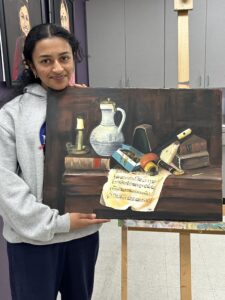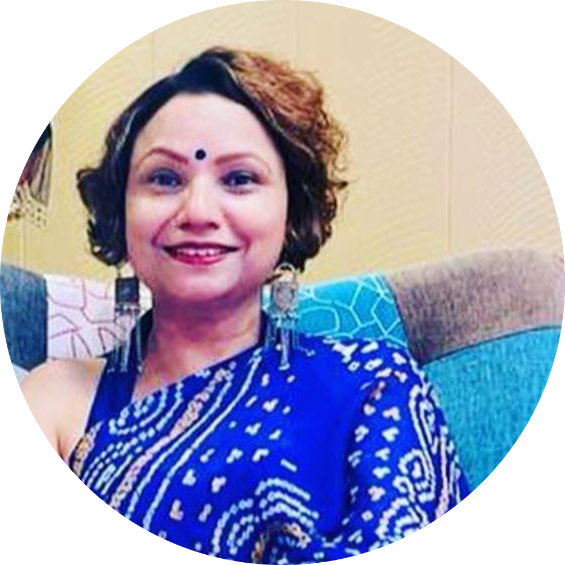My Tween Brush Strokes-The Golden Gate Bridge
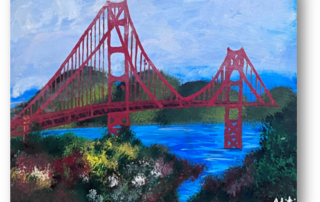
By- Aditi Manchanda, Sophomore 2022 This painting is of the Golden Gate Bridge and is one of my oldest paintings. I made it when I was in 6th grade. It has so many memories associated with it that I thought to document them in my art blog; “Better late than never :)’I don’t remember much of that time but I do remember the many skills I learned from this painting. It was the basis for all the paintings I have made since then. I learned many valuable painting techniques such as how to use shading in an image to make something look 3d, dabbing the paintbrush to make flowers and bushes, how to paint water realistically, and how to make clouds. These are skills that I have used in several of my paintings since then and have improved at. I really enjoyed making this painting and I put a lot of hard work into it. I also want to talk about the significance of this painting. Living in the bay area has given me the luxury of visiting the Golden Gate Bridge. So many of my favorite memories were made there, hiking, walking across the bridge, visiting Golden Gate Beach, and Golden Gate Park. I have been there so many times with so many different family members and friends that sometimes I forget that people travel from all over the world just to see it. It is a beauty that I take for granted and it attracts over 10 million people a year from all over the world. I never really processed that I lived near a historical world-famous landmark. This painting is a reminder of all the fun times I have had in my life with the people I love but more importantly, it is a reminder to never take things for granted.
Mumma Bear;Shading Techniques
By Saira Siraj, 7th Grade The first artwork (of the two that I will be talking about) that we did is a shading techniques page. Here we have 4 different ways to shade in a drawing, shading, scumbling, stippling, and hatching. I first made a 16by16 grid towards the bottom of the page. Then we drew two long rectangles, on the top of the page. In the first one, we made lines inside, making equal parts. Then we shaded the rectangle from lightest to darkest. Then below that, we made the same scale but as a gradient, this time with no partitions. In the 16by16 grid on the bottom half of the page, we made columns of different shapes, spheres, cubes, cylinders, and cones. We shaded each row with a different technique. Hatching, Scumbling, Stippling, and Shading. Scumbling was the easiest as it was like scribbling and Stippling took the longest because you have to be very careful with the dots and make sure they don’t look like lines. Hatching, Scumbling, and even Cross Hatching, all are similar because, to make the value darker, you need to make the lines/scribbles closer together to show the tightness. Our next artwork was a drawing of a mama bear and a baby bear. We were allowed to use any techniques that we wished, so I decided to do shading, as it would not take up as much time and I could still get a good-looking drawing. I started off by sketching the two bears. Then, we shaded the cave and the crevices of the bears really dark.
Chaos in Oneself
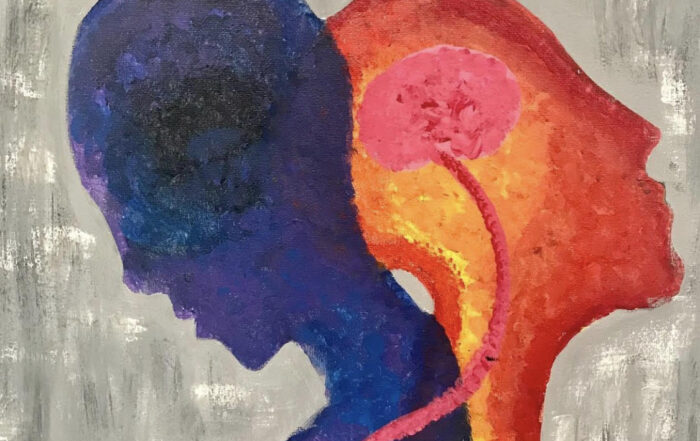
By- Saesha Sharda, Freshman, 2020 “Life doesn’t make any sense without interdependence. We need each other, and the sooner we learn that the better for us all.” — Erik Erikson In the present artwork, I have chosen to write focuses on the struggles of having bipolar disorder. Bipolar disorder is a mental illness characterized by extreme swings of high and low moods. The high mood is known as the manic phase, and the low mood is known as the depressive phase(“Bipolar Disorder: Symptoms, Causes, Diagnosis, Treatment.”). In my painting, I have shown two human-resembling figures balancing on each others’ backs, connected by the brain and heart. One figure is blue and has a heart painted on its chest. This figure represents the depressive phase, as blues and purples usually represent sad, somber moods. The other figure, which is yellow and has a brain painted in its head, represents the manic phase, as we normally pair the color yellow with high energy. The reason the heart and brain are shown is to represent their connection: Rational thinking (the brain) and Emotions (the heart). The figures are part of the same person, symbolizing how the two phases occur to the same person, affecting the same person, making it especially hard to get through daily life. The reason I wanted to create this painting was that I am passionate about raising awareness about not only bipolar disorder, but mental health issues in general. It is so important that we spread the word about mental illnesses and coping with them so that we can break the stigma that surrounds them. Stigma is a word to describe the social disapproval or discrimination against a person based on their characteristics, physical or mental. It is the fear of the stigma that keeps people suffering from mental health issues from coming forward about their struggles. In the Indian community especially, stigma against mental health issues is very apparent. The more we talk about it, the closer we are to helping someone cope with their mental illness and even saving lives. Submitting my painting to Vosap’s International Competition about disabilities was the perfect opportunity to share my art, and spread awareness about mental health issues. Work Cited: “Bipolar Disorder: Symptoms, Causes, Diagnosis, Treatment.” WebMD, WebMD, www.webmd.com/bipolar-disorder/mental-health-bipolar-disorder#:~:text=Bipolar%20disorder%2C%20also%20known%20as,sad%2C%20hopeless%2C%20and%20sluggish.
Healing Power of Art- Kalaa Art & Design
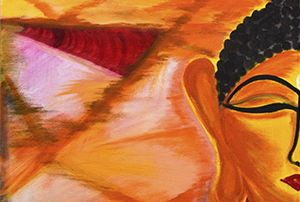
Healing power of artKala Art & Design “The arts are a critical component of healthcare. Expressive art is a tool to explore, develop and practice creativity as a means to wellness.” ~ Wellarts Association ART has the power to heal, offer hope. ART enhances individuals, society and the environment. Decades of research have provided more than a sufficient amount of data to prove that arts education impacts everything from overall academic achievement to social and emotional development and so much more. Research has proven the arts develop neural systems that produce a broad from fine motor skills to creativity and improved emotional balance. Every time you engage in a new or complex activity, your brain creates new connections between brain cells. Your brain’s ability to grow connections and change throughout your lifetime is called brain plasticity or neuroplasticity. Creating art stimulates communication between various parts of the brain. And this is the mere reason why art is important in our daily lives. Art and design process makes life worthwhile. It may not be vital to fulfill our basic needs; it does make life joyful.


